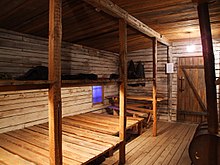Museum of the Occupation of Latvia
Latvijas Okupācijas muzejs | |
History museum, Memorial museum | |
| Collection size | 60,000 |
|---|---|
| Director | Solvita Vība |
| Owner | Occupation Museum Association |
| Website | www |
The Museum of the Occupation of Latvia (
The institution also operates an exhibition in the Corner House - the former KGB headquarters in Riga.
After 10 years of reconstruction work, a new permanent exhibition was opened to the public on June 1, 2022.[3][4] A day before the exhibition was attended by the President of Latvia, Egils Levits, and the Minister of Culture, Nauris Puntulis.
History



The museum was established in 1993 after
The first exhibition of the museum opened on 1 July 1993. The exhibition covered the period of the first Soviet occupation of Latvia from 1940 to 1941. The museum was expanded in the following years to cover the whole occupation period.[5]
Mission
The museum's stated mission is to:
- "Show what happened in Latvia, its land and people under two occupying totalitarian regimes from 1940 to 1991;
- "Remind the world of the crimes committed by foreign powers against the state and people of Latvia;
- "Remember the victims of the occupation: those who perished, were persecuted, forcefully deported or fled the terror of the occupation regimes.[2]
The Museum Collection
When the museum was established it began to collect objects relating to the occupation periods. The collection, as of the beginning of 2017, contained nearly 60,000 registered items. The collection also includes an audiovisual archive containing more than 2,300 video testimonials of deportees, refugees, and others affected by the occupations of Latvia. The audiovisual department has also made 10 documentary films.[2]
Building
The main museum building was built by the Soviets in 1971 to celebrate what would have been the 100th birthday of
The works were ultimately finished in late 2021, and in November the museum started its relocation back to the original building and the construction of the new permanent exhibition. The wall-shaped "Tactile of History' (Latvian: Vēstures taktīla) memorial to the victims of Soviet occupation was unveiled next to the museum in summer 2021. The completed exhibition was opened to the public on June 1, 2022.[11][4]
See also
- Soviet Occupation Day, Latvia
- Museum of Occupationsin Tallinn, Estonia
References
- ^ "Permanent exhibition". The Museum of the Occupation of Latvia (in Latvian). Retrieved 17 March 2018.
- ^ a b c "About us". The Museum of the Occupation of Latvia (in Latvian). Retrieved 17 March 2018.
- Latvijas Sabiedriskais medijs. 2022-06-01. Retrieved 2022-07-01.
- ^ lsm.lv. 2022-05-27. Retrieved 2022-07-01.
- ^ "Par muzeju". Latvijas Okupācijas muzejs (in Latvian). Retrieved 17 March 2018.
- ^ "Clashes over rebuilding key Old Riga museum". Public Broadcasting of Latvia. July 3, 2015. Retrieved 2018-09-26.
- Latvijas Sabiedriskais medijs. Retrieved 2018-09-26.
- ^ "Getting here". Museum of the Occupation of Latvia 1940-1991. Retrieved 24 February 2017.
- ^ "Okupācijas muzejs pārceļas". Pilseta24.lv (in Latvian). 2012-10-26. Retrieved 2018-09-26.
- Latvijas Sabiedriskais medijs. Retrieved 2018-09-26.
- lsm.lv. 2018-09-13. Retrieved 2022-02-15.
